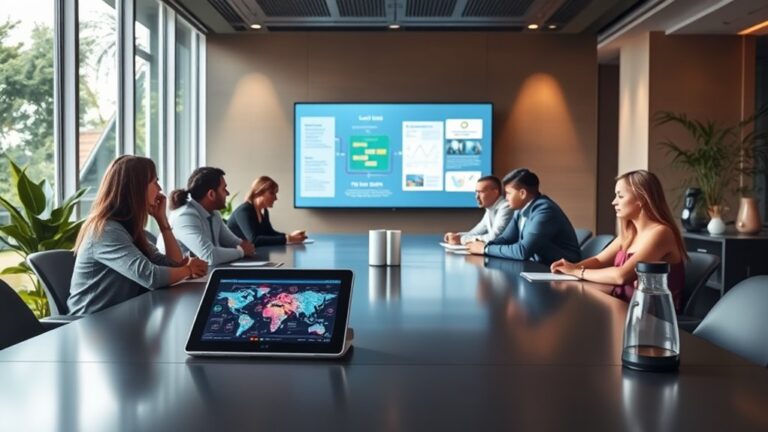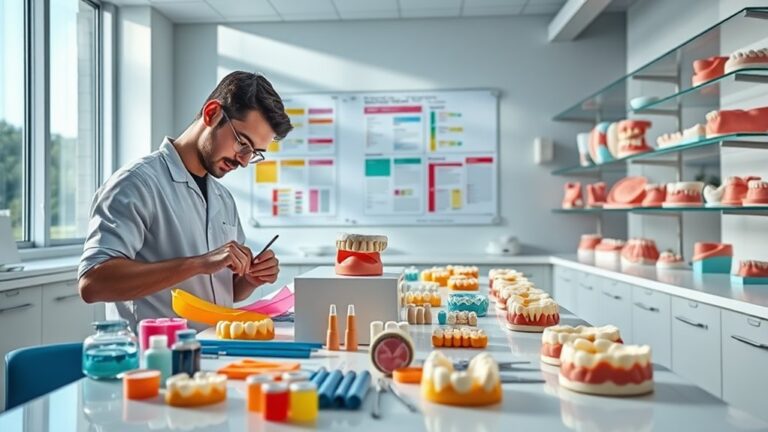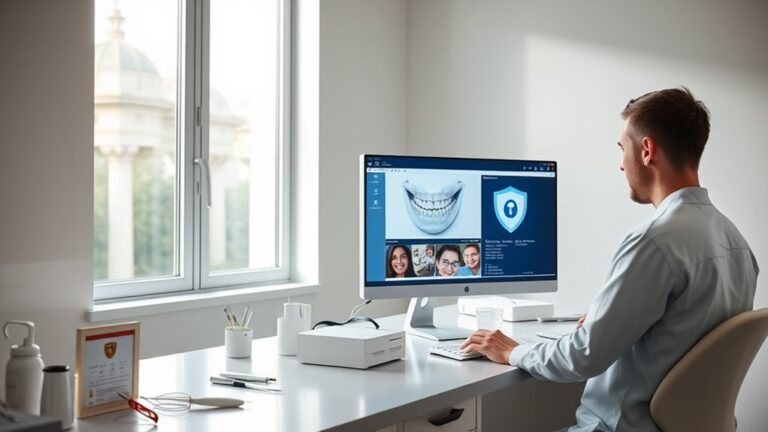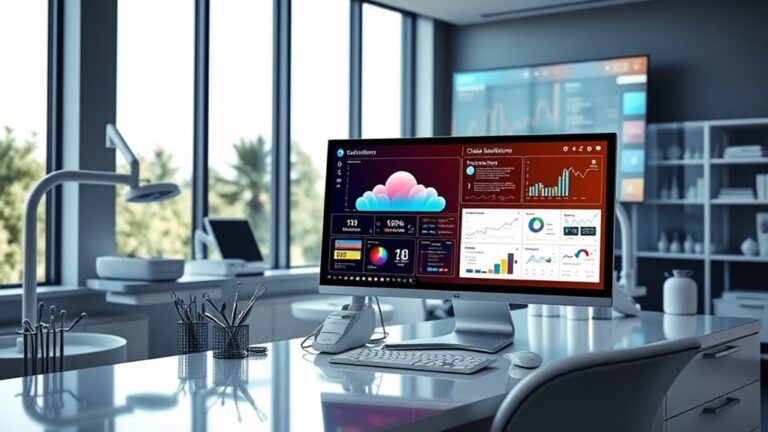7 Best Strategies to Minimize Lab Communication Breakdowns
If lab communication breakdowns were an Olympic sport, you'd likely win gold every time. But it doesn't have to be that way. By implementing seven strategic approaches, you can transform your lab into a well-oiled machine where clarity and collaboration thrive. From setting clear goals to utilizing digital solutions, these strategies can greatly enhance your team's efficiency. Curious about how to tackle these common pitfalls and foster a more effective communication landscape? Let's explore these essential strategies together. If you need further assistance, feel free to reach out to us. We can connect you with experts who can provide tailored solutions for improving communication in your lab.
Establish Clear Goals
Establishing clear goals is essential for any laboratory's success. You need to align your goals with organizational priorities, ensuring they stem from strategic needs or improvement areas. By adopting SMART criteria—specific, measurable, attainable, relevant, and time-bound—you'll create goals that are clear and achievable.
Focus on key areas such as communication and conflict resolution to drive improvement. Involving all team members is critical for fostering collective purpose. Make sure everyone understands the goals to enhance goal alignment across the lab.
Goal documentation is also important; develop a detailed plan with actionable steps and milestones to serve as your roadmap. Transparent communication helps disseminate this information effectively, so craft a communication plan that maintains consistent messaging. Additionally, regular assessments of team performance can provide insights into how well your goals are being met and where adjustments may be necessary.
Regular updates on progress keep the team informed and motivated, while feedback mechanisms allow for adjustments based on team input.
Finally, align individual roles with the overall goals so each member knows how their work contributes to the lab's success. By implementing these strategies, you'll minimize communication breakdowns and create a cohesive, goal-oriented laboratory environment.
Hold Regular Team Meetings
Clear goals set the foundation for effective teamwork, but holding regular team meetings is what truly keeps communication flowing. Establishing a consistent meeting frequency, like scheduling lab meetings every Thursday from 13:00 to 14:30, guarantees everyone stays informed and aligned. This routine minimizes scheduling conflicts and fosters a predictable communication environment. Regular attendance fosters communication and collaboration among lab members, ensuring that everyone is on the same page.
Effective agenda setting is vital for keeping discussions focused and relevant. Prior to each meeting, prepare a structured agenda that includes topics such as new papers, data presentations, and any pressing issues. This structure not only addresses specific concerns but also allows time for troubleshooting and support among team members.
Encouraging active participation in these meetings promotes open dialogue and honest feedback. Set ground rules to guarantee respectful communication, and foster a culture of active listening. This approach creates a safe space where everyone feels valued and heard.
Utilizing technology enhances the impact of your meetings. Tools like Microsoft Teams and shared documents facilitate ongoing collaboration, while follow-up summaries reinforce key points and action items.
Clarify Roles and Responsibilities
When team members understand their specific roles and responsibilities, the likelihood of communication breakdowns diminishes greatly. To achieve role clarity, assign clear tasks to each team member and guarantee these responsibilities are well-defined and communicated.
Utilize job descriptions and role outlines to set clear expectations, and provide training focused on these specific tasks. Regularly review and update role definitions to keep everyone aligned. Additionally, fostering an environment of open communication encourages team members to share any uncertainties regarding their roles.
Establishing standardized communication protocols is also essential. Implement protocols for various scenarios, like critical result notifications and equipment failures, and make sure they're accessible and understood by all.
Use predefined templates to maintain consistency and clarity during urgent situations.
Ongoing education is key to enhancing staff performance. Offer training on effective communication methods, emphasizing active listening and clear expression.
Encourage questions and feedback to foster a culture of open dialogue.
Lastly, implement quality assurance measures to monitor communication processes. Regular audits and feedback can identify areas for improvement, ensuring compliance with regulatory standards and enhancing patient safety.
Utilize Digital Lab Solutions
Utilizing digital lab solutions can considerably enhance communication and collaboration within your team. By adopting these tools, you'll streamline processes and guarantee that everyone is on the same page, ultimately improving productivity and outcomes.
Here are four key benefits of utilizing digital solutions in your lab:
- Centralized Communication: Platforms like ELNs and LIMS serve as a single conduit for sharing updates and data, promoting clear communication channels.
- Real-Time Collaboration: You can engage in digital collaboration, enabling team members to work together instantly, reducing delays and improving efficiency. Effective collaboration is essential for enhancing research quality through diverse perspectives.
- Enhanced Data Accessibility: With centralized data storage and instant access to relevant information, team members can effortlessly retrieve and review the necessary documentation.
- Improved Project Management: Utilize built-in project management tools to track progress, allocate resources effectively, and automate routine tasks, guaranteeing smooth project execution.
Address Communication Challenges
Effective communication is fundamental for any lab's success, and addressing challenges head-on can greatly improve team dynamics. Start by establishing clear goals and objectives for your projects. Verify these are specific, measurable, achievable, relevant, and time-bound (SMART), allowing everyone to stay aligned and focused. Additionally, utilizing collaboration tools can help streamline communication and ensure everyone is on the same page.
Share these goals openly with your team, and revisit them regularly to adapt to changes.
Clarifying roles and responsibilities is equally important. Define each team member's tasks clearly to prevent overlap and confusion. Providing detailed job descriptions during onboarding sets clear expectations, fostering accountability.
Listening skills also play a significant role in overcoming communication hurdles. Encourage active listening by promoting techniques like reflective listening to confirm understanding. This prevents misunderstandings and guarantees all voices are heard.
When communication breakdowns occur, address them constructively. Approach misunderstandings promptly, using empathy and active listening to facilitate open dialogue.
Summarize key points and document resolutions to solidify agreements and prevent future issues.
Implementing these strategies creates robust feedback mechanisms that enhance your lab's communication framework, ultimately leading to a more cohesive and effective team environment.
Foster Open Communication
Building on established communication strategies, fostering open communication is essential for creating a collaborative lab environment. When you prioritize open communication, you build trust and encourage a feedback culture that enhances teamwork. Open communication fosters teamwork by ensuring that all team members feel valued and included, leading to more innovative solutions.
Here are four key strategies to implement:
- Lead by Example: Model active listening during meetings. Show that you value input by being approachable and welcoming honest feedback.
- Open-Door Policy: Create an accessible environment where team members feel free to discuss concerns or share ideas without hesitation. This inclusivity guarantees that all voices are heard.
- Structured Opportunities: Hold regular team meetings and brainstorming sessions. These platforms allow employees to voice their thoughts, reinforcing the idea that every contribution matters.
- Diverse Communication Channels: Offer multiple ways for team members to communicate, whether face-to-face or through digital platforms. This accommodates different preferences and encourages constructive feedback.
Use Effective Communication Tools
Communication tools play an indispensable role in enhancing collaboration within a lab environment. By implementing effective communication platforms, you can streamline processes and improve data sharing. Start by utilizing Electronic Lab Notebooks (ELNs) and Laboratory Information Management Systems (LIMS) to centralize project management and enhance operational efficiency.
Integrating these platforms allows for real-time communication, reducing misunderstandings and errors. Leveraging effective communication tools like project management software to track progress and assign tasks clearly minimizes lengthy email threads and keeps everyone on the same page.
Verify the chosen tools are user-friendly and accessible, fostering a culture of collaboration. Providing training on these tools can greatly enhance adoption and effectiveness.
Instant messaging platforms offer quick communication options, while video conferencing tools facilitate meetings across different locations. This flexibility is vital for teams working varying shifts or in diverse settings.
Maintain proper messaging etiquette to foster professionalism and clarity in communication. Regularly seek feedback from staff on the usability of these tools to guarantee they meet your lab's needs.
Frequently Asked Questions
How Can We Assess the Effectiveness of Our Communication Strategies?
To assess your communication strategies, implement feedback mechanisms and conduct communication audits. These tools provide insights into effectiveness, highlight areas for improvement, and guarantee everyone's aligned, ultimately enhancing your ability to serve others efficiently.
What Are the Signs of Communication Breakdowns in a Lab Setting?
In a lab setting, communication breakdowns often showcase misunderstood protocols and unclear expectations, leading to confusion and chaos. When channels lack clarity, critical updates get missed, hindering collaboration and ultimately affecting patient care.
How Can We Encourage Shy Team Members to Speak Up?
To encourage shy team members to speak up, incorporate icebreaker activities during meetings and organize regular feedback sessions. These approaches create a comfortable atmosphere, fostering confidence and inviting everyone to share their insights without hesitation.
What Technologies Can Enhance Real-Time Communication Among Lab Teams?
In the fast-paced lab environment, instant messaging and collaborative tools are your lifelines. They foster seamless communication, ensuring everyone stays informed and engaged, transforming your team's productivity into a well-orchestrated symphony of innovation and teamwork.
How Do Cultural Differences Impact Lab Communication and Collaboration?
Cultural differences greatly impact lab communication and collaboration. You'll encounter language barriers that hinder understanding. Prioritizing cultural awareness can bridge these gaps, fostering effective interactions and enhancing teamwork among diverse collaborators in your lab environment.
Conclusion
By implementing these seven strategies, you can transform your lab's communication landscape, paving the way for improved collaboration and efficiency. However, if you choose not to act, the risk of miscommunication lingers, potentially derailing your team's progress. Imagine a project stalled due to unclear roles or unresolved challenges.
Don't face these challenges alone! Reach out to us for expert assistance with the issues discussed in this blog post. Our guidance can save you time, reduce stress, and significantly enhance your lab's performance. The choice is yours: embrace these practices and watch your lab thrive, or ignore them and face the consequences. The future of your lab's success hangs in the balance, and we're here to help you navigate it.





